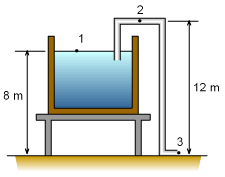| Ch 7. Incompressible and Inviscid Flow | Multimedia Engineering Fluids | ||||||
|
Bernoulli's Equation |
Flow Measurements |
Superposition of Flows |
Flow around Cylinder |
||||
| Bernoulli's Equation | Case Intro | Theory | Case Solution | Example |
| Chapter |
| 1. Basics |
| 2. Fluid Statics |
| 3. Kinematics |
| 4. Laws (Integral) |
| 5. Laws (Diff.) |
| 6. Modeling/Similitude |
| 7. Inviscid |
| 8. Viscous |
| 9. External Flow |
| 10. Open-Channel |
| Appendix |
| Basic Math |
| Units |
| Basic Fluid Eqs |
| Water/Air Tables |
| Sections |
| eBooks |
| Dynamics |
| Fluids |
| Math |
| Mechanics |
| Statics |
| Thermodynamics |
| ©Kurt Gramoll |
| |
||
|
|
Applying Bernoulli's equation between points 1 and 2 yields For a large open tank, p1 = 0 (gage pressure) and V1 = 0. Rearranging the above equation to gives Thus the pressure at point 2 can be determined once the velocity at point 2 (V2) is known. To determine V2, apply Bernoulli's equation between points 1 and 3, and recognize that the velocity at points 2 and 3 is equal for constant diameter pipe and a steady rate of flow. The pipe outlet acts as a free jet, so p3 = 0 (gage pressure), and z3 = 0 (datum). Thus the velocity at point 2 is then given by The gage pressure at point 2 thus can be simplified as, p2 = -0.5ρ (2gz1) + ρg (z1 -
z2) To avoid cavitation (i.e., p2 cannot be less than the vapor pressure), the maximum height of z2 should be |
|

